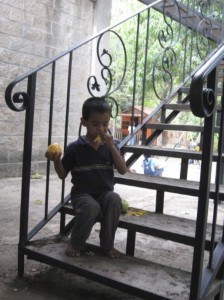Many of the children whose parents consult me suffer from a condition called encopresis, or soiling, a distressing problem that is diagnosed in children older than 4-years old. Encopresis usually starts with constipation. If a child experiences pain when passing a hard or large stool, it is common for the child to tighten up and hold back in response to the urge to defecate. This of course makes the constipation worse, and often soft stool from higher in the gut leaks around the hard mass in the colon, causing soiling.
The first step in dealing with this problem is to go to the pediatrician. Good medical care is essential to the treatment of these symptoms. If the constipation is not treated the withholding is likely to continue and may cause anatomical changes in the gut such as stretching of the muscular intestinal wall. Children who suffer from chronic constipation may also develop a disturbed coordination of muscle function in the anal sphincter. Medical treatment often involves stool softeners that draw water into the gut and soften the stool, making it easier and less painful to pass. There are other more vigorous and more intrusive interventions that can be used if necessary.
Pediatricians also often recommend behavioral plans. The most effective behavioral plan is for parents to gently but firmly insist that the child sit on the toilet after mealtimes – usually breakfast and supper – twice a day for 5-10 minutes. The natural movements of the intestines after meals aid in defecation. Sometimes small rewards or star charts help motivate children to follow through with this plan.
If this is a typical pediatric problem, why is it a concern for a child psychiatrist? The main reason is that there are three groups of children who might come to me for another reason who are also prone to having encopresis. The first is anxious children, the second is aggressive children, and the third is children with developmental problems such as attention deficit disorder (ADHD) or autistic spectrum disorders (ASD).
When I describe anxious and aggressive children as belonging to different groups I am only referring to their outward behavior. Most anxious children are afraid of the destructive potential of their own aggression (even if their general behavior is timid and withdrawn). Similarly, children with aggressive behavior usually struggle with the fear that their aggression will get out of control and hurt someone – especially a family member or themselves. What is a natural response to the fear of something dangerous getting of control? Control it! In other words, hold it in. Since children make meaning with and about their bodies even more than adults do, they “hold it in” concretely and physically. This psychological meaning almost always occurs simultaneously with the biological meaning of the threat of passing a hard stool. In my office practice, it is common for a child who allows himself to freely play an aggressive theme, such as dinosaurs biting each other, to interrupt the play and go into the bathroom to poop.
Children with developmental problems are even more interesting. In addition to all the other reasons mentioned above, they have difficulty picking up their body’s cues such as the urge to defecate. This is because they have trouble paying attention to their body’s signals and also because they sometimes cannot decipher them. Some children with ASD need to be told to put on a coat or mittens when it is cold outside since they don’t notice the cold feeling without help. (Readers may be surprised when I link the diagnoses ADHD and ASD in the general category of developmental problems, but I think that is the most sensible way to understand them.)
Helping children with their fears and helping them learn to pay attention to the signals their bodies send them is very important, but nothing can take the place of a regular bathroom routine of sitting on the toilet for 5-10 minutes after breakfast and supper. So why do parents find this so difficult to do? One reason is that the child who is afraid of passing a painful stool will object, and parents of fearful children often have trouble insisting that they face challenges that frighten them. Another reason is that the child with attentional problems or the child who has trouble reading body cues will often “tune out” while sitting on the toilet (sometimes get lost in a book). While “tuning out” will sometimes not prevent a bowel movement, the child who is not paying attention to his body will not learn how to respond to his body’s signals. That is why I do not recommend letting a child read or play with an iPad while sitting on the toilet. It is difficult, but it is a good exercise for both parent and child to help the child tolerate this routine.


